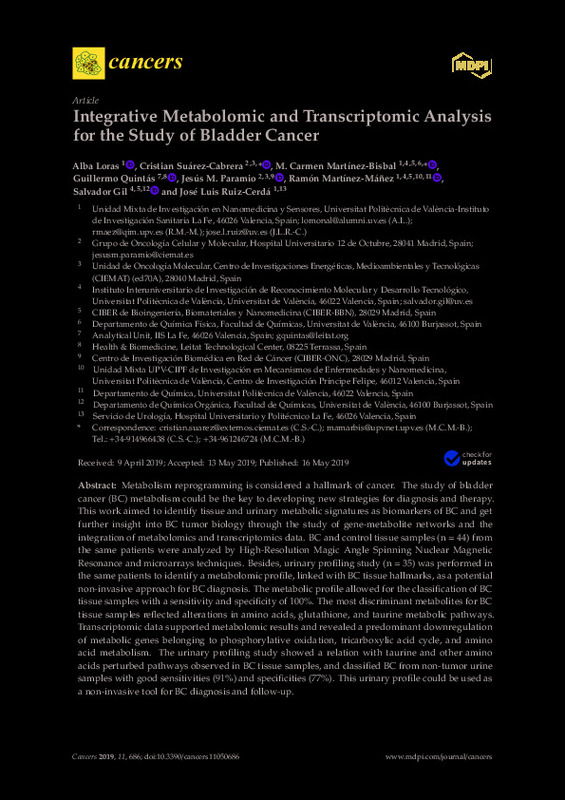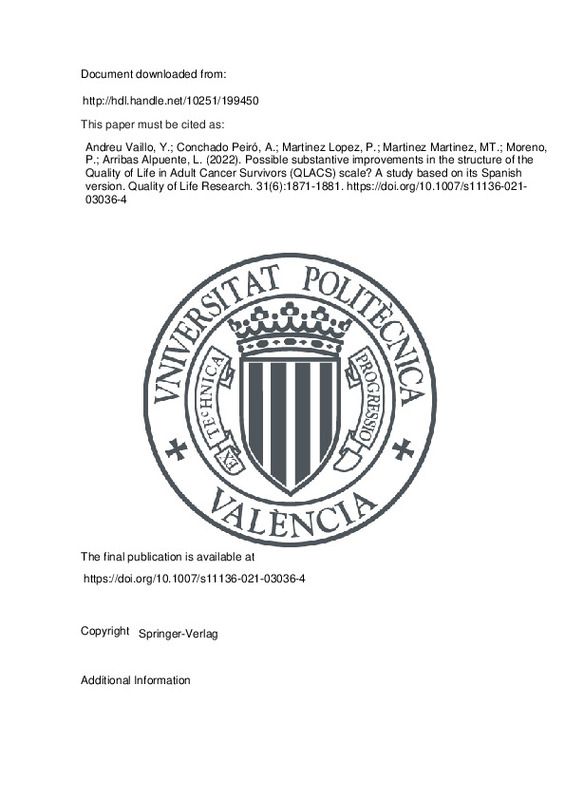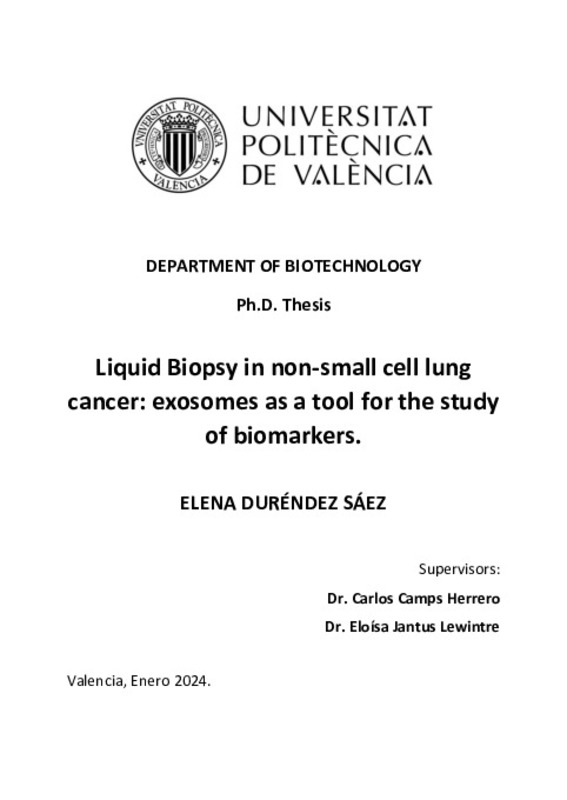JavaScript is disabled for your browser. Some features of this site may not work without it.
Buscar en RiuNet
Listar
Mi cuenta
Estadísticas
Ayuda RiuNet
Admin. UPV
Circulating DNA is a useful prognostic factor in patients with advanced non-small cell lung cancer
Mostrar el registro sencillo del ítem
Ficheros en el ítem
| dc.contributor.author | Sirera Pérez, Rafael
|
es_ES |
| dc.contributor.author | Bremnes, Roy M.
|
es_ES |
| dc.contributor.author | Cabrera, Andrea
|
es_ES |
| dc.contributor.author | Jantus Lewintre, Eloisa
|
es_ES |
| dc.contributor.author | Sanmartin, Elena
|
es_ES |
| dc.contributor.author | Blasco, Ana
|
es_ES |
| dc.contributor.author | del Pozo, Nieves
|
es_ES |
| dc.contributor.author | Rosell, Rafael
|
es_ES |
| dc.contributor.author | Guijarro, Ricardo
|
es_ES |
| dc.contributor.author | Galbis, Jose
|
es_ES |
| dc.contributor.author | Sanchez, Jose Javier
|
es_ES |
| dc.contributor.author | Camps, Carlos
|
es_ES |
| dc.date.accessioned | 2017-01-24T12:43:03Z | |
| dc.date.available | 2017-01-24T12:43:03Z | |
| dc.date.issued | 2011-02 | |
| dc.identifier.issn | 1556-0864 | |
| dc.identifier.uri | http://hdl.handle.net/10251/77269 | |
| dc.description.abstract | Background: Circulating DNA is observed at higher concentrations in patients with lung cancer than in controls. Qualitative and quantitative analysis of circulating DNA is a promising noninvasive tool. Our aim was to prospectively study the association between the catalytic subunit of telomerase (human telomerase reverse transcriptase [hTERT]) in plasma and clinical variables and survival in a large-scale non-small cell lung cancer (NSCLC) study. Methods: Four hundred forty-six patients with stages IIIB and IV NSCLC with a median follow-up of 9.7 months (range, 0.5-45) were analyzed. Blood samples were collected before therapy start (cisplatin/docetaxel). Quantification of baseline circulating DNA was determined as the amount of free hTERT in plasma, by using real-time quantitative polymerase chain reaction. Results: Patients with hTERT ¿49.8 ng/ml (median value) had a median time to progression (TTP) of 6.3 months compared with 4.9 for hTERT more than 49.8 ng/ml (p = 0.001). Overall survival (OS) was significantly higher (10.9 versus 9.3 months) at lower hTERT levels (p = 0.012). When calculations were done using hTERT as continuous variable, we did not observe independent significant differences. Thus, there is an apparent discrepancy in p values when hTERT is considered as a continuous versus dichotomized variable. There was a tendency to differentiate median hTERT levels with respect to response rates (complete response + partial response: 33.1 versus stable disease + progressive disease: 50.7 ng/ml, p = 0.12), but other clinical variables such as age, gender, performance status, stage, histology, and number of metastatic locations were not associated with hTERT. In multivariate analysis, hTERT was an independent prognostic variable for both TTP (hazard ratio: 1.44, p < 0.001) and OS (hazard ratio: 1.33, p = 0.007). Conclusions: In advanced NSCLC, high pretreatment circulating hTERT level is an independent poor prognostic marker for TTP and OS. Circulating DNA is a noninvasive marker, which may help to improve the prognostic profile of these patients. Copyright © 2011 by the International Association for the Study of Lung Cancer. | es_ES |
| dc.description.sponsorship | Supported, in part, by the Spanish Society of Medical Oncology (SEOM). | en_EN |
| dc.language | Inglés | es_ES |
| dc.publisher | Lippincott, Williams & Wilkins | es_ES |
| dc.relation.ispartof | Journal of Thoracic Oncology | es_ES |
| dc.rights | Reserva de todos los derechos | es_ES |
| dc.subject | HTERT | es_ES |
| dc.subject | Nonsmall cell lung cancer | es_ES |
| dc.subject | NSCLC | es_ES |
| dc.subject | Plasma | es_ES |
| dc.subject | Prognostic factors | es_ES |
| dc.subject | Telomerase | es_ES |
| dc.subject | Circulating DNA | es_ES |
| dc.subject | Cisplatin | es_ES |
| dc.subject | DNA | es_ES |
| dc.subject | Docetaxel | es_ES |
| dc.subject | Telomerase reverse transcriptase | es_ES |
| dc.subject | Unclassified drug | es_ES |
| dc.subject | Adult | es_ES |
| dc.subject | Advanced cancer | es_ES |
| dc.subject | Aged | es_ES |
| dc.subject | Article | es_ES |
| dc.subject | Blood sampling | es_ES |
| dc.subject | Cancer combination chemotherapy | es_ES |
| dc.subject | Cancer patient | es_ES |
| dc.subject | Cancer staging | es_ES |
| dc.subject | Cancer survival | es_ES |
| dc.subject | Controlled study | es_ES |
| dc.subject | Diagnostic test accuracy study | es_ES |
| dc.subject | Enzyme active site | es_ES |
| dc.subject | Female | es_ES |
| dc.subject | Follow up | es_ES |
| dc.subject | Gender and sex | es_ES |
| dc.subject | Histology | es_ES |
| dc.subject | Human | es_ES |
| dc.subject | Lung non small cell cancer | es_ES |
| dc.subject | Major clinical study | es_ES |
| dc.subject | Male | es_ES |
| dc.subject | Multicenter study | es_ES |
| dc.subject | Priority journal | es_ES |
| dc.subject | Prognosis | es_ES |
| dc.subject | Quantitative analysis | es_ES |
| dc.subject | Real time polymerase chain reaction | es_ES |
| dc.subject | Adenocarcinoma | es_ES |
| dc.subject | Aged, 80 and over | es_ES |
| dc.subject | Carcinoma, Large Cell | es_ES |
| dc.subject | Carcinoma, Non-Small-Cell Lung | es_ES |
| dc.subject | Carcinoma, Squamous Cell | es_ES |
| dc.subject | DNA, Neoplasm | es_ES |
| dc.subject | Follow-Up Studies | es_ES |
| dc.subject | Humans | es_ES |
| dc.subject | Lung Neoplasms | es_ES |
| dc.subject | Middle Aged | es_ES |
| dc.subject | Neoplasm Staging | es_ES |
| dc.subject | Polymerase Chain Reaction | es_ES |
| dc.subject | Prospective Studies | es_ES |
| dc.subject | Survival Rate | es_ES |
| dc.subject | Tumor Markers, Biological | es_ES |
| dc.subject.classification | MICROBIOLOGIA | es_ES |
| dc.title | Circulating DNA is a useful prognostic factor in patients with advanced non-small cell lung cancer | es_ES |
| dc.type | Artículo | es_ES |
| dc.identifier.doi | 10.1097/JTO.0b013e31820189a5 | |
| dc.rights.accessRights | Cerrado | es_ES |
| dc.contributor.affiliation | Universitat Politècnica de València. Escuela Técnica Superior de Ingeniería Agronómica y del Medio Natural - Escola Tècnica Superior d'Enginyeria Agronòmica i del Medi Natural | es_ES |
| dc.description.bibliographicCitation | Sirera Pérez, R.; Bremnes, RM.; Cabrera, A.; Jantus Lewintre, E.; Sanmartin, E.; Blasco, A.; Del Pozo, N.... (2011). Circulating DNA is a useful prognostic factor in patients with advanced non-small cell lung cancer. Journal of Thoracic Oncology. 6(2):286-290. doi:10.1097/JTO.0b013e31820189a5 | es_ES |
| dc.description.accrualMethod | S | es_ES |
| dc.relation.publisherversion | https://dx.doi.org/10.1097/JTO.0b013e31820189a5 | es_ES |
| dc.description.upvformatpinicio | 286 | es_ES |
| dc.description.upvformatpfin | 290 | es_ES |
| dc.type.version | info:eu-repo/semantics/publishedVersion | es_ES |
| dc.description.volume | 6 | es_ES |
| dc.description.issue | 2 | es_ES |
| dc.relation.senia | 221101 | es_ES |
| dc.contributor.funder | Sociedad Española de Oncología Médica | es_ES |






![[Cerrado]](/themes/UPV/images/candado.png)




